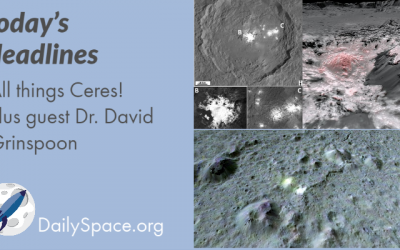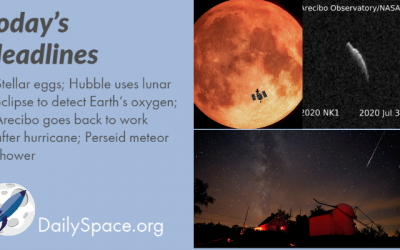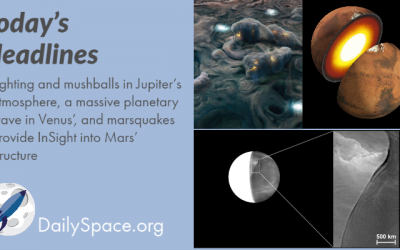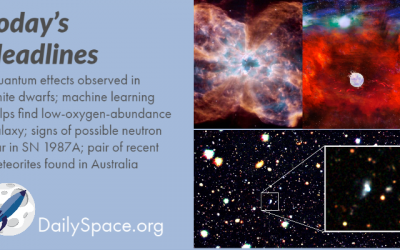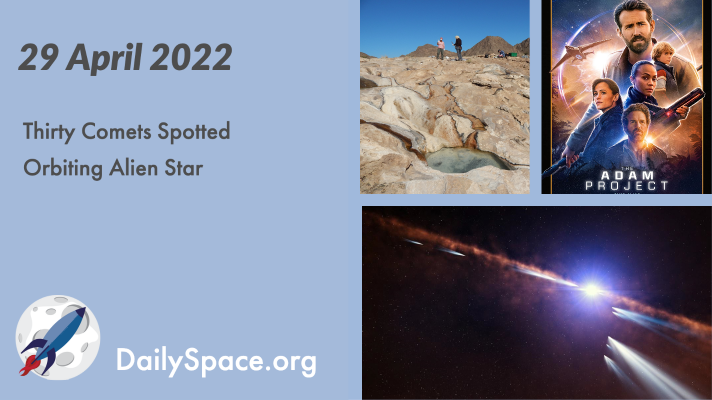
Thirty Comets Spotted Orbiting Alien Star
Using data from TESS, a new paper presents evidence for the discovery of thirty potential comets orbiting in the Beta Pictoris system. Plus, astrobiology research, water on the Moon, solar system formation, and a review of “The Adam Project” starring Ryan Reynolds.
Catch us on NowMedia TV
Saturday 11pm Central / midnight Eastern
Sunday 10pm Central / 11pm Eastern
Watch live on these stations: Houston 21.10, Atlanta 22.10
or tune-in on Apple TV, Roku, YouTube Live, or Amazon Prime
All things Ceres! Plus guest Dr. David Grinspoon
Join us today as we cover all the news about Ceres that culminated in SEVEN papers, revealing the existence of a salty subsurface ocean and active cryovolcanism.
Stellar eggs; Hubble uses lunar eclipse to detect Earth’s oxygen; Arecibo goes back to work after hurricane; Perseid meteor shower
Join us today for news about the evolution of stellar eggs. Additionally, Hubble takes advantage of a lunar eclipse to probe our atmosphere. Then we celebrate Arecibo reopening after Hurricane Isaias and doing more science. Plus it’s time for the Persieds!
Lighting and mushballs in Jupiter’s atmosphere, a massive planetary wave in Venus’, and marsquakes provide InSight into Mars’ structure
Join us today for a trio of solar system stories! First, shallow lightning and mushballs in Jupiter’s atmosphere help find “missing” ammonia. Next, a massive planetary wave in Venus’ atmosphere goes back at least 35 years. Finally, InSight’s seismograph provides the first direct measurement of subsurface boundaries.
Rocket Roundup for August 5, 2020
Join us for this week’s Rocket Roundup with host Annie Wilson as we look back at the launches that did and didn’t happen, including the Mars Perseverance launch, a Roscosmos launch, and the splashdown of the SpaceX Demo-2 capsule. Plus! A surprise Starship SN5 hop.
Free-flowing water on ancient Mars? Not so fast! Plus a black hole fails to prevent star formation and unequal neutron stars colliding may be noisy.
Join us today as we talk about newly released research that suggests the waters on ancient Mars were subglacial and not free-flowing. Also, a black hole goes dormant and star formation goes wild. Meanwhile, computer models show that unequal neutron stars colliding may cause a big “bang” that can be detected on Earth.
Quantum effects observed in white dwarfs; machine learning helps find low-oxygen-abundance galaxy; signs of possible neutron star in SN 1987A; pair of recent meteorites found in Australia
Join us today as we look at how quantum mechanics and Einstein’s theory of general relativity work together in white dwarfs. Machine learning is used to find a galaxy with an extremely low abundance of oxygen. Scientists find signs of a neutron star in supernova 1987A. And researchers managed to locate two recently arrived meteorites in Australia with the help of fireball detection cameras.


 We record most shows live, on Twitch. Follow us today to get alerts when we go live.
We record most shows live, on Twitch. Follow us today to get alerts when we go live.

